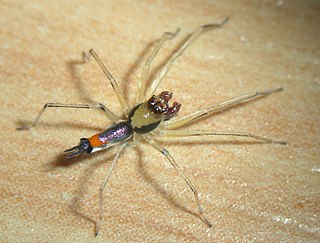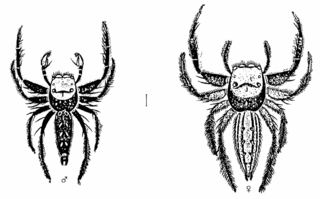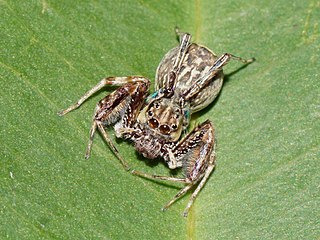
Myrmarachne is a genus of ant-mimicking jumping spiders that was first described by W. S. MacLeay in 1839. They are commonly called antmimicking spiders, but they are not the only spiders that have this attribute. The name is a combination of Ancient Greek μύρμηξ (myrmex), meaning "ant", and ἀράχνη (arachne), meaning "spider".

Afromarengo is a genus of jumping spiders that was first described by S. P. Benjamin in 2004. The name is derived from "Africa" and the genus Marengo. The genus Indomarengo is similarly named.

Asemonea is a genus of jumping spiders that was first described by Octavius Pickard-Cambridge in 1869.

Bavia is a genus of jumping spiders.

Brettus is a genus of jumping spiders. Its six described species are found in southern Asia from India to China and Sulawesi, with a single species endemic to Madagascar.

Carrhotus is a genus of jumping spiders that was first described by Tamerlan Thorell in 1891. The name is derived from the Greek Κάῤῥωτος.
Erasinus is a genus of the spider family Salticidae.
Goleba is a genus of African jumping spiders that was first described by F. R. Wanless in 1980.

Harmochirus is a genus of the spider family Salticidae.

Hasarius is a spider genus of the family Salticidae.

Heliophanus is a genus of the spider family Salticidae. Most of the almost 170 described species occur in Africa, with many others found in the Palearctic region from Europe to Japan.

Hyllus is a genus of the spider family Salticidae.
Macopaeus is a genus of jumping spiders endemic to Madagascar. It contains only one species, Macopaeus spinosus. Two other species were described in this genus in the early 20th century. However, these were transferred to the genus Brettus in 1980.
Meleon is a genus of jumping spiders that was first described by F. R. Wanless in 1984.
Padilla is a genus of jumping spiders that was first described by George and Elizabeth Peckham in 1894. Most males have a characteristic long, forward projecting process on each chelicera that looks like a lance that is bent near the tip. The exception is P. javana, that doesn't have this feature.
Pandisus is a genus of jumping spiders that was first described by Eugène Louis Simon in 1900.

Barychelidae, also known as brushed trapdoor spiders, is a spider family with about 300 species in 42 genera. Most spiders in this family build trapdoor burrows. For example, the 20 millimetres (0.79 in) long Sipalolasma builds its burrow in rotted wood, with a hinged trapdoor at each end. The 10 millimetres (0.39 in) long Idioctis builds its burrow approximately 5 centimetres (2.0 in) deep, just below the high tide level, sealing the opening with a thin trapdoor.
Hispo alboclypea is a species of jumping spider. The species is endemic to Mahé Island and Silhouette Island of Seychelles.










